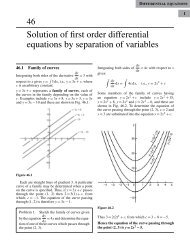vector
You also want an ePaper? Increase the reach of your titles
YUMPU automatically turns print PDFs into web optimized ePapers that Google loves.
Vectors 389<br />
Since the scalar product of grad u, grad v and grad w are zero, hence these <strong>vector</strong>s are<br />
coplanar <strong>vector</strong>s.<br />
Proved.<br />
Example 18. Find the directional derivative of x 2 y 2 z 2 at the point (1, 1, –1) in the direction<br />
of the tangent to the curve x = e t , y = sin 2t + 1, z = 1 – cos t at t = 0.<br />
(Nagpur University, Summer 2005)<br />
Solution. Let = x 2 y 2 z 2<br />
Directional Derivative of <br />
2 2 2<br />
= = i j k ( x y z )<br />
x y z<br />
<br />
2 2 2 2 2 2<br />
= 2xy z i 2yx z j 2zx y k<br />
Directional Derivative of at (1, 1, –1)<br />
Tangent <strong>vector</strong>,<br />
=<br />
Tangent(at t = 0) =<br />
<br />
2 2 2 2 2 2<br />
2(1)(1) ( 1) i 2(1)(1) ( 1) j 2( 1)(1) (1) k<br />
<br />
= 2 i 2 j 2k<br />
...(1)<br />
t<br />
<br />
<br />
r<br />
= xi yj zk e i (sin 2t 1) j (1<br />
cos t)<br />
k<br />
<br />
T dr <br />
t<br />
= e i 2cos 2tj<br />
sin tk<br />
dt<br />
<br />
0<br />
e i 2(cos 0) j (sin 0) k i 2 j<br />
...(2)<br />
( i 2 j)<br />
Required directional derivative along tangent = (2 i 2 j 2 k)<br />
1<br />
4<br />
[From (1), (2)]<br />
= 2 4 0 6 Ans.<br />
5 5<br />
Example 19. Find the unit normal to the surface xy 3 z 2 = 4 at (–1, –1, 2). (M.U. 2008)<br />
Solution. Let (x, y, z) = xy 3 z 2 = 4<br />
We know that is the <strong>vector</strong> normal to the surface (x, y, z) = c.<br />
<br />
Normal <strong>vector</strong> = = i <br />
x j <br />
y k<br />
<br />
<br />
z<br />
Now =<br />
Normal <strong>vector</strong> =<br />
<br />
i ( xyz) j ( xyz) k ( xyz)<br />
x y z<br />
<br />
3 2 3 2 3 2<br />
<br />
3 2 2 2 3<br />
yz i 3xy z j 2xyzk<br />
<br />
Normal <strong>vector</strong> at (–1, –1, 2) = 4i 12 j 4k<br />
Unit <strong>vector</strong> normal to the surface at (–1, –1, 2).<br />
<br />
4i 12 j 4k<br />
1 <br />
= ( i 3 j k ) Ans.<br />
| | 16 144 16 11<br />
Example 20. Find the rate of change of = xyz in the direction normal to the surface<br />
x 2 y + y 2 x + yz 2 = 3 at the point (1, 1, 1). (Nagpur University, Summer 2001)<br />
Solution. Rate of change of =<br />
<br />
<br />
= i j k ( x yz)<br />
iyz jxz kxy<br />
x y z










